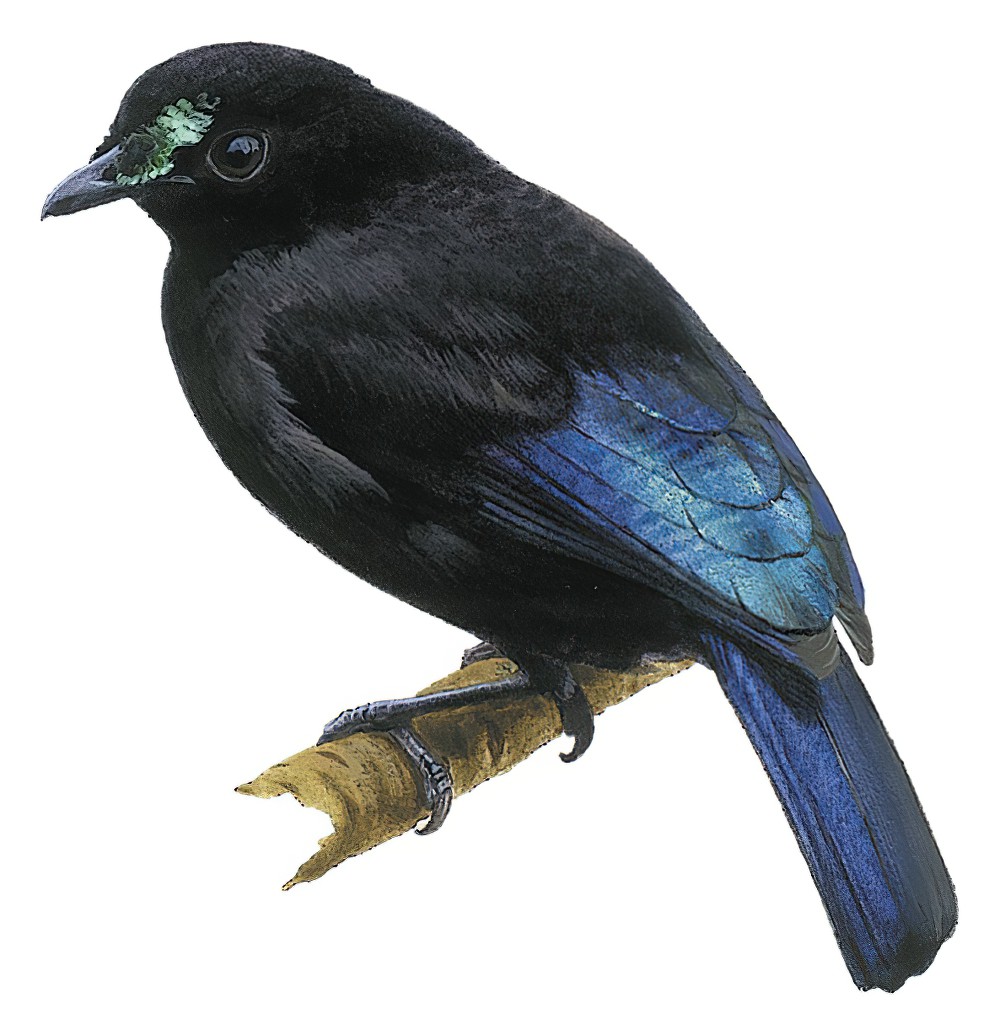Loria’s Satinbird / Cnemophilus loriae

Loria's Satinbird
SCI Name:
Protonym: Loria loriae Ann.Mus.Civ.Stor.Nat.Genova 34 p.151
Taxonomy: Passeriformes / Cnemophilidae / Cnemophilus
Taxonomy Code: lorsat1
Type Locality: Moroka, Owen Stanley Range.
Author: Salvadori
Publish Year: 1894
IUCN Status: Least Concern
DEFINITIONS
CNEMOPHILUS
(Cnemophilidae; Ϯ Yellow Satinbird C. macgregorii) Gr. κνημος knēmos mountain-slope; φιλος philos lover; "This is a very distinct kind of Bower Bird, obtained on Mount Knutsford, at an elevation of 11,000 feet, and rivalling the Regent Bird in beauty. The name Cnemophilus (Mountain-slope Lover) has been appropriated to it, and the species I propose, with permission, to dedicate to yourself. ... 72. CNEMOPHILUS, n. g.—PTILONORHYNCHIDÆ. Bill shorter than head, broader than high; culmen rounded, curved towards the tip; edge of maxilla notched at the tip; nostril basil, oval, almost concealed by elongated nasal plumes directed forwards; basil profile of mandible straight. Wing short, rounded, reaching to tarsus; primaries longer than secondaries by half the length of the hallux without claw, first primary two-thirds of the second in length; tip of wing formed by the 4th, 5th, 6th, and 7th quills. Tarsus moderate in length, stout; scutellation entire fore and aft. Feet strong, hallux equalling the mid toe without claw; laterals unequal. CNEMOPHILUS MACGREGORII. Loreal, frontal, and nasal plumes elongate, and forming a fronto-nasal crest; from its frontal end a compressed backwardly curved crest of four feathers reaching the occiput; feathers of head parted mesially forming a groove for reception of the crest. Lower part of fronto nasal crest chestnut-black, upper part, front, and over fore part of orbit fiery orange-red. ... Hab. Mount Knutsford, at 11,000 feet.—1 male. Of the habits of this bird we have no information; it was shot by one of the party at some distance from their camp; no other was seen. The systematic place of the genus seems to be between Amblyornis and Xanthomelus." (DeVis 1890); "Cnemophilus DeVis, 1890, Ann. Rep. British New Guinea, 1888-89, p. 5, Appendix G, pp. 58, 61. Type, by monotypy, Cnemophilus macgregorii DeVis, 1890." (JAJ 2020). Cracraft 1992, postulated two diagnosably distinct species in Cnemophilus sens. str.
Synon. Loria.
loriae
Dr Lamberto Loria (1855-1913) Italian ethnologist, explorer, collector in New Guinea (syn. Aegotheles wallacii, syn. Casuarius bennetti, Cnemophilus (cf. “presumably in honour of the wife of the discoverer Dr Lamberto Loria” (Frith & Beehler 1998)), subsp. Erythropitta macklotii, subsp. Ptilorrhoa leucosticta).
SUBSPECIES
Loria's Satinbird (amethystinus)
SCI Name: Cnemophilus loriae amethystinus
amethystina / amethystinus
L. amethystinus amethyst-coloured, amethystine < amethystus amethyst < Gr. αμεθυστος amethustos amethyst.
● ex “Petit oiseau-mouche à queue fourchue de Cayenne”” of d’Aubenton 1765-1781, pl. 672, fig. 1, and “Améthiste” of de Buffon 1770-1783 (Calliphlox).
● ex “Petit oiseau-mouche à queue fourchue de Cayenne”” of d’Aubenton 1765-1781, pl. 672, fig. 1, “Améthiste” of de Buffon 1770-1783, and “Amethystine Hummingbird” of Latham 1782 (syn. Calliphlox amethystina).
● ex “Sucrier Velours” of Levaillant 1810, pl. 294 (Chalcomitra).
Loria's Satinbird (inexpectatus)
SCI Name: Cnemophilus loriae inexpectatus
inexpecta / inexpectata / inexpectatum / inexpectatus / inexpectus / inexspectata / inexspectatus
L. inexspectatus unexpected, surprising, unlooked for < in- not; exspectatus awaited, expected < exspectare to await.
● “In view of the stability shown by Arremonops conirostris conirostris through a wide area, the appearance of this form so near the type-locality of that race is surprising and inexplicable” (Chapman 1914) (subsp. Arremonops conirostris).
● “It certainly was unexpected to find such a striking and hitherto unknown species on Guadalcanar, and this and the discovery of other new forms on the island shows that the ornithological exploration of Guadalcanar has hitherto been very imperfect” (Hartert 1929) (Guadalcanaria).
● “et necata inexpectatum nobis gaudium dedit novae speciei, ante nunquam visae” (Forster 1844) (Pterodroma).
● "Named both for the unexpected nature of its distribution, being restricted to two provinces of Ghana, and the fact that there are no obvious geographic barriers that separate it from two other members of the genus" (Voelker et al. 2016) (subsp. Stiphrornis erythrothorax).
● “On examining a large series of birdskins collected in the northern parts of Celebes and presented to the Leyden Museum by S. C. I. W. van Musschenbroek, Esq., I was quite astonished to find, that there exists in the Minahassa, beside Strix [= Tyto ] Rosenbergii, another large species of Barn-owl, very different as well from Strix Rosenbergii as from all the other known species” (Schlegel 1879) (Tyto).
Loria's Satinbird (loriae)
SCI Name: Cnemophilus loriae loriae
loriae
Dr Lamberto Loria (1855-1913) Italian ethnologist, explorer, collector in New Guinea (syn. Aegotheles wallacii, syn. Casuarius bennetti, Cnemophilus (cf. “presumably in honour of the wife of the discoverer Dr Lamberto Loria” (Frith & Beehler 1998)), subsp. Erythropitta macklotii, subsp. Ptilorrhoa leucosticta).
UPPERCASE: current genus
Uppercase first letter: generic synonym
● and ● See: generic homonyms
lowercase: species and subspecies
●: early names, variants, mispellings
‡: extinct
†: type species
Gr.: ancient Greek
L.: Latin
<: derived from
syn: synonym of
/: separates historical and modern geographic names
ex: based on
TL: type locality
OD: original diagnosis (genus) or original description (species)












